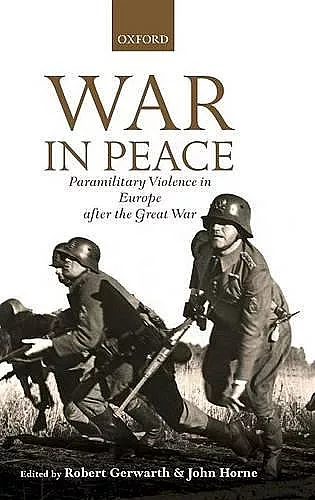War in Peace
Paramilitary Violence in Europe after the Great War
John Horne editor Robert Gerwarth editor
Format:Hardback
Publisher:Oxford University Press
Published:27th Sep '12
Currently unavailable, and unfortunately no date known when it will be back
This hardback is available in another edition too:
- Paperback£47.49(9780199686056)

The First World War did not end in November 1918. In Russia and Eastern Europe it finished up to a year earlier, and both there and elsewhere in Europe it triggered conflicts that lasted down to 1923. Paramilitary formations were prominent in this continuation of the war. They had some features of formal military organizations, but were used in opposition to the regular military as an instrument of revolution or as an adjunct or substitute for military forces when these were unable by themselves to put down a revolution (whether class or national). Paramilitary violence thus arose in different contexts. It was an important aspect of the violence unleashed by class revolution in Russia. It structured the counter-revolution in central and Eastern Europe, including Finland and Italy, which reacted against a mythic version of Bolshevik class violence in the name of order and authority. It also shaped the struggles over borders and ethnicity in the new states that replaced the multi-national empires of Russia, Austria-Hungary and Ottoman Turkey. It was prominent on all sides in the wars for Irish independence. In many cases, paramilitary violence was charged with political significance and acquired a long-lasting symbolism and influence. War in Peace explores the differences and similarities between these various kinds of paramilitary violence within one volume for the first time. It thereby contributes to our understanding of the difficult transitions from war to peace. It also helps to re-situate the Great War in a longer-term context and to explain its enduring impact.
The quality of the individual essays is for the most part high, and a majority of the essays engages productively with each other, particularly those by the editors, and those on Russia, Italy, the Balkans and the Ottoman Empire. * Pieter M. Judson, Slavonic and East European Review *
essential reading for anyone interested in the way violence at the end of the Great War led into the post-war period with profound and devastating effects. This innovative collection of essays helps shift the centre of gravity of twentieth-century European studies to the east, and does so through illuminating studies of the breakdown of the state's monopoly on violence from Ireland to Turkey and beyond. * Jay Winter, Yale University *
a volume that not only eases the inherent difficulty in understanding post-war themes of societal disillusionment, and political and ethnic struggle, but is committed to advancing the discourse on the social, cultural, and psychological impact of the Great War. * Justin Dolan Stover, War in History *
this collection is undoubtedly a major contribution to the debate. It brings together an impressive selection of concise yet substantial introductions to complex cases, many of which Western scholars often overlook. Indeed, the book eloquently demonstrates the inadequacy of other histories of Europe that concentrate on West European experiences in that it shows how events in Central and Eastern Europe are integral parts of the continent's past, not aberrations to a Western norm. * Christopher Gilley, Europe-Asia Studies *
War in Peace offers a valuable look not only at the 'war after the war' but also on the nature of paramilitary conflict, and the origins of fascism and collaborationism. * The NYMAS Review *
War in Peace is a thorough, incisive read for any scholar and enthusiast of 20th century European history ... an ideal book for understanding more about the internecine politics that led to both world wars. * Farisa Khalid, PopMatters *
ISBN: 9780199654918
Dimensions: 241mm x 161mm x 21mm
Weight: 528g
256 pages